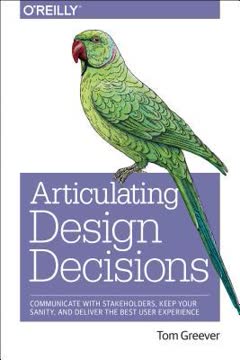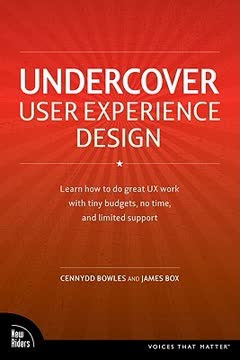Key Takeaways
1. Embrace undercover UX design to drive change from within
We believe in going undercover. We don't mean you should skulk around in the dark. As an undercover user experience designer, your mission is to get people excited about UX without them realizing what you've done.
Start small and persistent. Undercover UX design is about introducing user-centered practices subtly and incrementally within organizations that may not prioritize UX. Focus on achieving small victories that demonstrate the value of UX, rather than pushing for sweeping changes all at once. Build credibility by consistently delivering results that improve both user satisfaction and business outcomes.
Lead by example. Instead of preaching about UX, incorporate user-centered methods into your daily work. Conduct quick usability tests, create basic personas, or sketch out user flows to inform your design decisions. As colleagues see the positive impact of these practices, they'll naturally become more receptive to UX principles. Remember, actions speak louder than words when it comes to changing organizational culture.
2. Conduct efficient user research to understand your audience
To get agreement for user research in these circumstances, you need to be involved in writing proposals, going to pitches, and getting clients to talk about user experience.
Leverage existing resources. When formal research budgets are scarce, get creative with your methods. Tap into customer service logs, analytics data, and informal conversations with users to gain insights. Consider guerrilla research techniques like intercepting users in public spaces or conducting quick hallway tests with colleagues.
Focus on key insights. Prioritize gathering the most critical user information that will directly impact your design decisions. Create lightweight personas and user journeys to capture essential user needs and behaviors. Use methods like card sorting or tree testing to quickly validate your information architecture. Remember, some user insight is better than none – don't let perfect be the enemy of good when it comes to understanding your audience.
3. Generate and explore ideas through collaborative design sessions
Design games are a perfect vehicle for collaborative design. Their hands-on, inclusive nature puts design in everyone's hands, encouraging a sense of shared ownership that other approaches lack.
Foster creativity and participation. Collaborative design sessions break down silos and generate diverse ideas. Use techniques like design studios, card sorting, or sketching exercises to engage stakeholders from various disciplines. These activities not only produce valuable design concepts but also build buy-in for the UX process across the organization.
Embrace divergent thinking. Encourage participants to generate many ideas without judgment in the early stages. Use prompts, constraints, or even role-playing to spark unconventional solutions. Follow divergent ideation with convergent activities to synthesize and refine the most promising concepts. This balanced approach ensures both creativity and practicality in your design outcomes.
4. Create appropriate design deliverables to communicate your vision
Deliverables are a stop on the journey, not the end of the line.
Choose wisely. Select deliverables that effectively communicate your design intent while being appropriate for your audience and project constraints. Consider the fidelity spectrum from low (sketches, wireframes) to high (interactive prototypes). Match the level of detail to the stage of the project and the decisions that need to be made.
Focus on outcomes. Remember that deliverables are tools for communication and decision-making, not ends in themselves. Prioritize creating artifacts that drive the project forward and facilitate meaningful conversations about user needs and design solutions. Be prepared to adapt your deliverables based on stakeholder feedback and changing project requirements. Key deliverables to consider:
- Personas and user journeys
- Site maps and user flows
- Wireframes and mockups
- Interactive prototypes
- Design specifications
5. Refine your solution through iterative testing and critique
Design, after all, is not a science. Although you can measure fundamental usability concepts such as process completion and error rates, user experience is also concerned with emotion, enjoyment, and desirability.
Balance qualitative and quantitative feedback. Conduct usability testing to observe how users interact with your designs and gather their thoughts and emotions. Complement this qualitative data with quantitative metrics like task completion rates, time on task, and satisfaction scores. Use A/B testing for specific design decisions when appropriate.
Embrace constructive critique. Foster a culture of open and honest feedback within your team and with stakeholders. Establish clear criteria for evaluating designs based on user needs, business goals, and design principles. Use techniques like design studios or critique sessions to gather diverse perspectives and refine your solutions. Remember that iteration is a natural part of the design process – be prepared to revise and improve based on new insights.
6. Collaborate effectively with diverse team members
You will find it easier to convince developers of the value of UX if you view them as partners, not adversaries.
Build bridges. Understand the priorities, constraints, and working styles of different team members:
- Developers: Appreciate their focus on efficiency and technical feasibility
- Visual designers: Respect their expertise in aesthetics and brand consistency
- Content specialists: Collaborate on information architecture and messaging
- Product owners: Align UX goals with business objectives
- Marketers: Find common ground in understanding user needs and behaviors
Communicate clearly. Tailor your communication style and deliverables to each audience. Use language and concepts that resonate with their perspectives. Be prepared to translate UX jargon into terms that make sense to non-designers. Foster an environment of mutual respect and learning, where each discipline's expertise is valued in creating a holistic user experience.
7. Demonstrate UX value to gain organizational buy-in
ROI is the holy grail of not just UX design but almost any design field. Unfortunately, a watertight business case would be pure fiction. Design can yield astonishingly profitable results, but how can you accurately predict the financial outcome of such a creative, complex act?
Speak the language of business. While it's challenging to quantify the full value of UX, focus on metrics that resonate with decision-makers:
- Increased conversion rates
- Reduced support costs
- Improved customer satisfaction scores
- Enhanced brand perception
- Decreased development rework
Tell compelling stories. Complement quantitative data with qualitative narratives that illustrate the impact of good UX. Share user quotes, before-and-after comparisons, and case studies of successful UX interventions. Demonstrate how investing in UX aligns with broader business goals and can provide a competitive advantage in the market.
Last updated:
Review Summary
Undercover User Experience Design receives mostly positive reviews for its practical approach to UX design. Readers appreciate its clear explanations, suggestions for tools, and applicability for beginners and experienced practitioners alike. The book is praised for covering foundational UX methods and phases, offering insights on working with different roles, and providing valuable career guidance. Some reviewers note that it's slightly dated and web-focused, but still relevant. A few critics find it basic or lacking in-depth theory, but most consider it an essential resource for those new to or transitioning into UX design.
Similar Books





Download PDF
Download EPUB
.epub digital book format is ideal for reading ebooks on phones, tablets, and e-readers.




